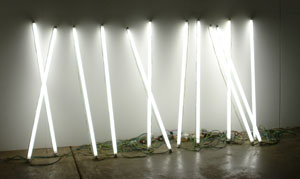Early colonial diaries, drawings and engravings offer a description of the unique cultural life of the Eora people of Sydney. By night, Eora would launch their noweys or bark skiffs into the harbour, complete with onboard fires contained on clay bases to attract and cook fish. The line of reflected light created by the floating fire across the harbour would meet Eora’s foreign observers. For me, this light is the physical realisation of Aboriginal/non-Aboriginal relations. It is often a polarised line of difference, though one of innate connections, as evident in the relationship between local hero and leader Woollarawarre Bennelong and Captain Arthur Philip, the colony’s first Governor. In a potent act of political kinship Bennelong called Philip, “Beanga”, meaning father, and in return has Philip call him “Doorow”, son. In 1790 Philip constructed Bennelong a stone hut on the point that today still bears his name. This connection between Bennelong and Philip is the line of light, Aboriginal and non-Aboriginal relations, at its most dynamic. This type of relation has been mirrored throughout Australian’s history and provides intercultural dialogue and possibilities.
The post-modern notion of layering histories and accepting a number various sources and perspectives as equally valid generates a new language. Again the benefits of this progressive notion can be seen in the relationship between Governor Philip and Bennelong. Within in the built environment of Sydney this new language of layering of culture can also be seen within colonial architecture where Aboriginal middens, major Indigenous structures, were mined and destroyed to produce the lime that was needed for the early brick buildings of the new culture. These buildings can still be seen in Sydney today. This way of operating within the space and drawing together cultural similarities is the line of reflection as seen across the Harbour from the onboard fires, the relationship between Philip and Bennelong, the use of shell middens in early buildings, creating a shared sense of space and drawing closer together a number of Australian paradigms to evoke a mutual memory.
Jonathon Jones

installation - fluorescent tubes and fitting
variable
